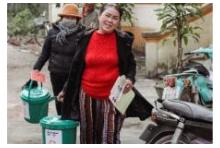On September 7, the Vietnam Meteorological and Hydrological Administration issued warnings about Typhoon Yagi, a powerful tropical storm forming in the South China Sea. While typhoon season in Vietnam typically brings heavy rains, Yagi’s erratic path and intense rainfall have raised alarm. In previous years, Vietnam’s extensive coastline has been the primary area affected by such storms, with mountainous regions experiencing lesser impacts. However, Typhoon Yagi has unleashed widespread destruction, moving inland and triggering catastrophic floods and landslides in both urban and rural areas, including major cities like Hanoi. The most affected regions have been the northern region of Than Hao.
As of September 15, at least 155 people have died, 141 people are missing, and at least 1,900 have been injured. Typhoon Yagi was the strongest typhoon to hit Vietnam in 30 years, affecting 19 million people in the most impacted provinces. Rivers have overflowed their banks, and flash floods have washed away homes and crops. Heavy rainfall has caused flooding and landslides which has resulted in widespread power outages, and communication loss, and more than 40,000 homes have been flooded. It is estimated that the typhoon has caused more than $1.6 billion in damages across the 26 northern affected provinces.
The typhoon has also dealt a heavy blow to livelihoods in Vietnam. Nearly 40% of Vietnam’s population depends on agriculture, and Typhoon Yagi has inundated more than 160,000 hectares and nearly 30,000 hectares of cash crops. This crisis comes at a time when Vietnam, like many other countries, is grappling with the ongoing effects of the COVID-19 pandemic, disruptions to global food and energy supply chains due to the Ukraine conflict, and rising inflation. The agricultural sector, which has been key to Vietnam’s economic recovery in recent years, now faces significant setbacks.
One of our top concerns is ensuring that the voices and needs of women and girls are taken into account as CARE and our partners launch emergency response efforts. While natural disasters affect everyone and everything in their path, their impacts – especially their long-term impacts – tend to disproportionately impact women, girls and other marginalized groups. CARE has a number of gender justice tools for emergency response that we have validated through years of humanitarian interventions around the world. In all of our emergency programming, we incorporate measures to prevent gender-based violence and provide safe spaces for vulnerable community members.
CARE has been continuously operating in Vietnam since 1989 and has worked in almost all of Vietnam’s 64 provinces and cities, providing more than 200 development projects, including in the areas most affected by the typhoon. At this time, CARE plans to prioritize response activities in the communities we already serve – to ensure that we address the most urgent needs of families and individuals who are already participating in CARE projects.
CARE is ready to respond, providing critical information, working alongside other humanitarian partners such as Oxfam. Under CARE’s emergency response mandate, CARE’s response in coordination with authorities, agencies, and sector members, is focused on rapid assessment, mobilization of partners and resources, sector coordination, emergency WASH and social protection, including humanitarian cash transfers to 35,000 of the most affected people.
CARE is also prepared to see these communities through to the medium and long-term recovery from the impacts of the typhoon. Our emergency assistance will complement our other programs that aim to build resiliency to shocks like Typhoon Yagi. We have strong partnerships with local stakeholders that will enable communities to build back better and stronger than ever before.
To further support the affected families of the norther region and aim in their livelihood recovery efforts, CARE is seeking to mobilize $1,500,000 from our partners to provide the following:
• WASH kits
• Hygiene kits
• Immediate needs items such as blankets, clothes, cooking utensils, etc.
• Cash transfers to provide emergency funds
• Provide protection awareness raising communication
• Deliver training to enhance and improve capacity
